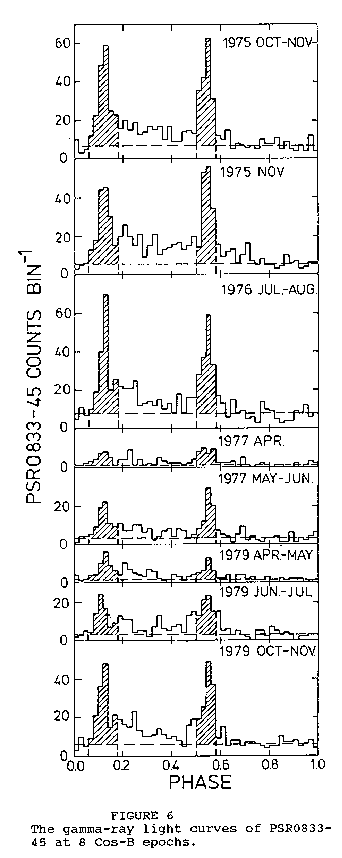Gamma Ray Pulsars - COS-B
Gamma-Ray Pulsars
Amongst the earliest celestial objects to be studied by Cos-B were the radio pulsars PSR0531+21 (Crab) and PSR0833-45 (Vela) and both have been observed several times:
 |
 |
the Crab is seen at six epochs (Figure 5) and Vela at nine (Figure 6) and, not shown, those in April-June 1981).
A major discovery resulted from comparing the light curves of the Vela and Crab pulsars for the different epochs. It is seen that while during several years the light curves of Vela remain unchanged the Crab's light curves vary. The strong pulse at phase 0.55 in the 1975 August observations is barely seen in the later observations (Ref.8). Meanwhile the light curve of the X-rays as measured on board Cos-B stayed rock-steady.
The last task of Cos-B was to view the anticentre region for an extended period of time. This observation was important to determine whether the light curve change had persisted and also to assess sensitivity changes which had occurred throughout the mission. The April 1982 light curve shows again the familiar strong double peak structure seen at the beginning of the mission and using the final sensitivity corrections Clear et al. (Ref.9) quantitatively confirm the Crab variability.
For Vela, Grenier et al. (Ref.10) find evidence for a change in intensity in the emission which seems to succeed a glitch in the period. Their detailed analysis also unearthed spectral dependencies of the light curve.
The differences in behaviour between these two ostensibly similar objects continue to accrue: recall that the first major surprise was the difference between the phases of the radio- and gamma-pulses already detectable in the data of SAS 2 (Ref.11) and subsequently confirmed by Cos-B (Ref.12).
A search for evidence of pulsed gamma-ray emission from the other known radio pulsars has proved fruitless. Because of the low rate of accumulation of gamma-ray events, it is necessary to fold the data from a whole month's observation with periods of the order of milliseconds. Accurate knowledge is requird of the pulsar period P and also of its derivative Pdot. Although published data were available for many of the 330 or so known radio pulsars, most of these require extrapolations of up to 5 years to the epoch of the Cos-B observations. In only a fraction of the cases is the extrapolated uncertainty in the parameters small enough to avoid smearing of the light curve. A study of over 100 such pulsars in the field of view of Cos-B yielded none for which there was any indication of pulsed emission above the 2Σlevel of confidence (Ref.13).
Young pulsars like Crab and Vela may still contribute significantly to the galactic emission but those young pulsars so far known are not bright gamma-ray sources and it must be borne in mind that intrinsically the Crab and Vela sources are quite low in luminosity compared with the sources of the Cos-B catalogue. Indeed Vela (at 500pc) would not have been visible had it been at the typical distance of a 2CG catalogue source (2-7kpc). Nevertheless searches for millisecond pulsars were attempted to no avail. A search for the recently discovered fast pulsar (Ref.14) in CTB80 (period 39.53 ms) was possible given the accuracies in P and Pdot. Data from four observations were analysed and no consistent signal was present in the data.
It looks unlikely that further retrospective searches will be feasible given the stringent requirements on P and Pdot in extrapolating to the Cos-B epoch.
- Removed a total of (2) align=bottom;
- Removed a total of (1) style float:left;
- Removed a total of (1) style float:right;
- Removed a total of (2) align=center.
- Removed a total of (1) border attribute.
- Removed a total of (1) cellpadding attribute.
- Removed a total of (1) cellspacing attribute.








































 Sign in
Sign in
 Science & Technology
Science & Technology